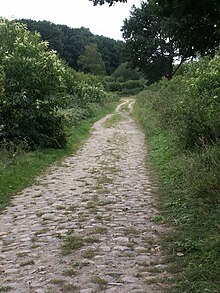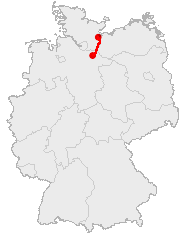Old Salt Road
The old salt route is an old trade route between Lüneburg and Lübeck .
history

The importance of the Old Salt Road as part of what was once the most important north-south connection in Germany goes back to prehistoric times. However, it reached its greatest importance from the 12th to the 16th century.
During the Hanseatic League , a large part of the Lüneburg salt was exported to the Baltic Sea region , where it was the basis for the herring trade . The main customer was the herring market in Falsterbo in Skåne . The main hub for the salt trade was Lübeck as the capital of the Hanseatic League and the most important Baltic port. There, the salt was temporarily stored in the salt stores that are still preserved today .
The salt was transported loose or in tons by freight wagons along the Old Salt Road. With the completion of the Stecknitz Canal in 1398, transport shifted to the waterway via Ilmenau , Elbe , the Stecknitz Canal and the Trave .
The Alte Salzstraße left Lüneburg via today's Lüner Straße and the Neubrücker Tor and passed the Stintfang, the old fish market at the Ilmenau harbor. It led across the river and Werder past the Lüne monastery to Adendorf and Brietlingen , where it left the Lüneburg Landwehr . It extended via Lüdershausen and a ferry over the Neetze to Artlenburg , where it crossed the Elbe via a ford and a ferry. The Elbe crossing of the Alte Salzstrasse from Artlenburg to Schnakenbek was secured in the 11th and 12th centuries by the Ertheneburg , which was set on fire in 1181 by Heinrich the Lion while fleeing from Emperor Friedrich Barbarossa . For a long time there was only one customs post at the crossing; today there is no longer a crossing of the Elbe.
The further course of the road went from Schnakenbek between Krüzen and Juliusburg through to Lütau , Wangelau , Pötrau ( Büchen ), Siebeneichen and Roseburg . From Roseburg it led via Hornbek , Woltersdorf and Breitenfelde to the fortress of Mölln , where the Stecknitz canal was crossed at the Hahnenburg lock house and the town was reached through the stone gate. Today's further route along the B 207 via Fredeburg to Ratzeburg was of little importance until the 17th century. In the Middle Ages, the Salzstraße led over a 62 meter long bridge, which no longer exists today, over the city lake and through the water gate over the former Marienwohlde monastery , Rotenfelde , the Albsfelder Berg to Behlendorf . From here it led down to Hollenbek , across the river of the same name and through Berkenthin to Krummesse . Here you reached the Lübeck Landwehr and got into the city through Rothebek .
Holiday route
Today the Alte Salzstraße is a holiday route that follows the federal road 209 from Lüneburg via Lauenburg to Schwarzenbek and then the federal road 207 via Mölln and Fredeburg along the Ratzeburg lake in the direction of Lübeck . It leads through the Lauenburg Lakes Nature Park and has only a few common waypoints with the historic route.
Old Salt Road long-distance cycle route
Predominantly along the Elbe-Lübeck channel of about 90 kilometers takes Radfernweg old road salt of Luneburg to Lübeck.
See also
- European long-distance hiking trails E1 and E6
- German Salt Museum in Lueneburg
literature
- Old Salt Road Cycle Path - On old trade routes from Lüneburg. Spiralo 1: 50,000, BVA Bielefelder Verlag, 2005, ISBN 978-3-87073-340-7
- Old Salt Road / Duchy of Lauenburg. Between Lüneburg and Travemünde. ADFC -Radausflugsführer 1: 50,000, BVA Bielefelder Verlag, 2013, ISBN 978-3-87073-526-5
- Hermann Harms, Hans-Jürgen Wohlfahrt: The old salt road through the ages . Karl Wachholtz Verlag, Neumünster 1989, ISBN 3-529-06177-8 .
Movie
- The old salt road. Documentary, Germany, 1998, 45 min., Script and director: Peter Moers, production: NDR , series: Bilderbuch Deutschland , first broadcast: April 5, 1998, film information from prisma .
Web links
- map
- Old salt road through northern Germany
- Old Salt Road through Central Germany and Bohemia
- 20,000 tons of "white gold" , an article about the Alte Salzstrasse in the online magazine of the German Foundation for Monument Protection , 2007, No. 1

